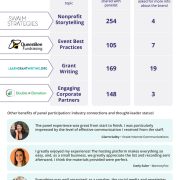NXUnite Custom Panels
Take center stage and host an epic panel on NXUnite!
With custom panels, you have the freedom to bring your vision to life. Whether you have a specific topic or a dream team of panelists in mind, get ready to seize the spotlight and create your ideal panel:
- Choose a topic that perfectly aligns with your team’s expertise
- Handpick a dream team of 2-3 industry experts
- Set the date and time that suits you best
- Cost: FREE
What’s in it for you?
- Tap into a vast community of 15,000+ mission-driven professionals
- Establish your brand as a thought leader and a trusted authority in the industry
- Leave the nitty-gritty logistics to us! Simply show up and shine at the event
Steps to Establishing Custom Panels:
- Express Your Interest: Notify your Nexus/NXUnite point of contact of your desire to set up a custom panel.
- Select Timing: Choose a suitable date and time from the options provided by the NXUnite team.
- Define Panel Topic: Put forward a topic for the panel, whether by suggesting a title or requesting our assistance in crafting one.
- Panelist Suggestions: Collaborate with the NXUnite team to compile a list of potential panelists who fit the designated category.
- As the panel organizer, you are responsible for identifying and reaching out to the roster of panelists you select.
- Panelists must meet the below requirements and be run by the NXUnite team before being invited:
- Serves the mission-driven sector
- Willing to send out marketing for the session preferably via email
- Not competitive with other selected panelists
- At least 1 of the panelists must be new to the NXUnite panel series (to align with our goal of showcasing new voices in the space)
- NXUnite will provide templates for making these introductions and will handle onboarding the panelists once they have agreed to join.
- Panelists must meet the below requirements and be run by the NXUnite team before being invited:
- As the panel organizer, you are responsible for identifying and reaching out to the roster of panelists you select.
-
- Outreach Template: After your NXUnite point of contact has approved the proposed panelists, use the provided template to contact the individuals.
- Hi [Panelist],
- Outreach Template: After your NXUnite point of contact has approved the proposed panelists, use the provided template to contact the individuals.
I wanted to connect you with [NXUnite contact] at Nexus Marketing Agency who coordinates the NXUnite panels. I’m speaking on a panel in [month] and would love for you to join me in this session.
Topic:
Date and Time:
[NXUnite contact] can follow up with more information but thought there might be an opportunity for you here.
[NXUnite contact] – I’ll let you take it from here.
Interested in joining the excitement and hosting a panel on NXUnite? Let us know.
Cross-Marketing Solicitation Advising for Partners
One thing we’ve heard from our partners is that they often get solicitations for collaborations from other businesses and don’t have time to sort through them.
We’d like to help you sort through these requests and prioritize the important ones.
When you get these inbound requests, send them directly to us and we’ll deal with them.
We’ll elevate the ones who are worth connecting with and help save you time!
Wondering how you opt-in to cross-marketing solicitation advising?
Simply start forwarding solicitations to your CPC with the following message in the body of your email: cross-marketing solicitation advising requested
Within 3 business days your CPC team member will reach back out to you with their insight and recommendation.
Have questions? Reach out to your CPC and they will be happy clarify!





